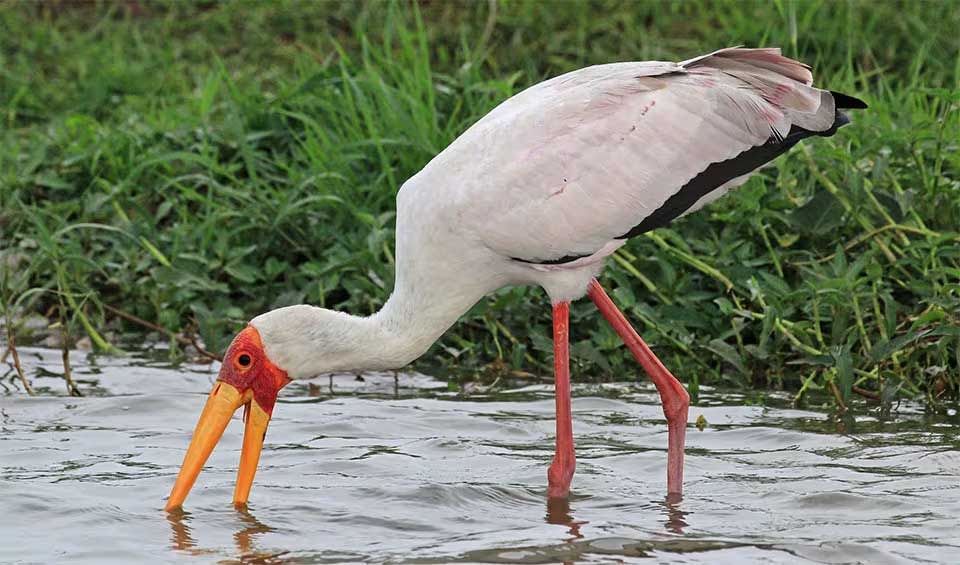The Yellow-billed, also known as the Wood Stork or Wood Ibis, is an elegant wading bird found in the wetlands and savannas of sub-Saharan Africa. With its distinctive long, yellow bill, which is slightly down-curved at the tip, and its striking white plumage with pink-tinged edges during the breeding season, this stork is a visually striking presence in its natural habitat.
The Yellow-billed Stork stands at about 90 to 105 cm (35 to 41 inches), with a wingspan that can reach up to 150 cm (59 inches). This species is particularly noted for its specialized feeding technique, which is both tactile and reactive. It forages in shallow waters, often alongside other waterbirds, using its sensitive bill to detect and snap up prey such as fish, frogs, insects, and crustaceans. This method of feeding, known as “grope feeding,” involves the bird walking slowly through the water with its bill submerged, waiting to feel the movement of prey.
The “snap-bill” reflex is an instantaneous closing of the bill when it comes into contact with potential food – a remarkable adaptation that allows for efficient hunting in murky waters where visibility is low. After capturing the prey, the Yellow-billed Stork will typically lift its head and use gravity to help swallow the catch.
Socially, Yellow-billed Storks can be somewhat gregarious, particularly when feeding or during the breeding season. They are known to form loose breeding colonies, often in association with other species of storks, herons, and ibises. While they are generally quiet birds, they do produce low-pitched, guttural sounds, especially in the nesting colonies, which can become quite noisy with the sounds of all the different species.
Distribution
 Angola
Angola Benin
Benin Botswana
Botswana Bulgaria
Bulgaria Burkina Faso
Burkina Faso Burundi
Burundi Cameroon
Cameroon Central Af. Rep.
Central Af. Rep. Chad
Chad Congo-Brazzaville
Congo-Brazzaville Côte D’ivoire
Côte D’ivoire DR Congo (Kinshasa)
DR Congo (Kinshasa) Djibouti
Djibouti Egypt
Egypt Equatorial Guinea
Equatorial Guinea Eritrea
Eritrea Eswatini
Eswatini Ethiopia
Ethiopia Gabon
Gabon Gambia
Gambia Ghana
Ghana Guinea-Bissau
Guinea-Bissau Guinea
Guinea Israel
Israel Jordan
Jordan Kenya
Kenya Lesotho
Lesotho Liberia
Liberia Madagascar
Madagascar Malawi
Malawi Mali
Mali Mauritania
Mauritania Morocco
Morocco Mozambique
Mozambique Namibia
Namibia Niger
Niger Nigeria
Nigeria Qatar
Qatar Rwanda
Rwanda Senegal
Senegal Sierra Leone
Sierra Leone Somalia
Somalia South Africa
South Africa South Sudan
South Sudan Spain
Spain Sudan
Sudan Tanzania
Tanzania Togo
Togo Tunisia
Tunisia Turkey
Turkey Uganda
Uganda Zambia
Zambia Zimbabwe
ZimbabweAnything we've missed?
Help us improve this page by suggesting edits. Glory never dies!
Suggest an editGet to know me
Terrestrial / Aquatic
Altricial / Precocial
Polygamous / Monogamous
Dimorphic (size) / Monomorphic
Active: Diurnal / Nocturnal
Social behavior: Solitary / Pack / Herd
Diet: Carnivore / Herbivore / Omnivore / Piscivorous / Insectivore
Migratory: Yes / No
Domesticated: Yes / No
Dangerous: Yes / No





